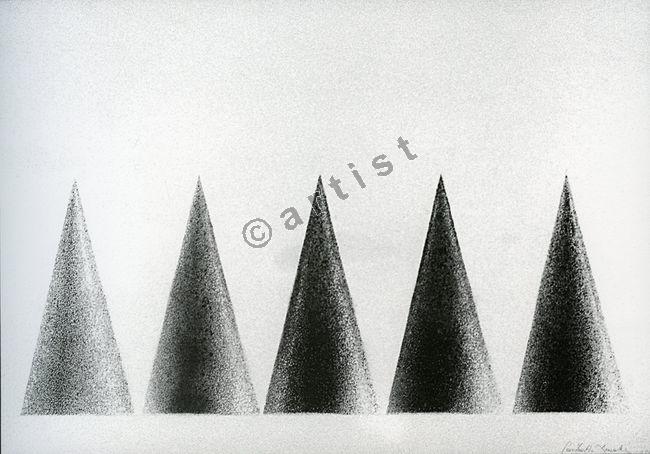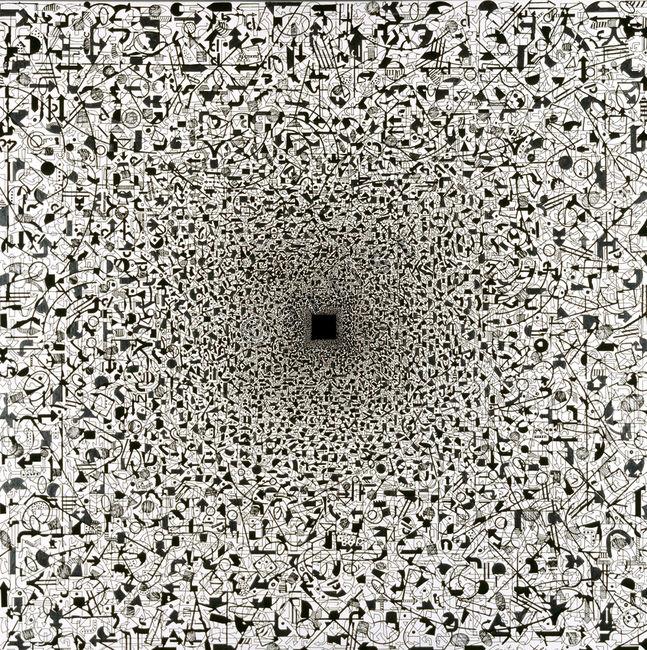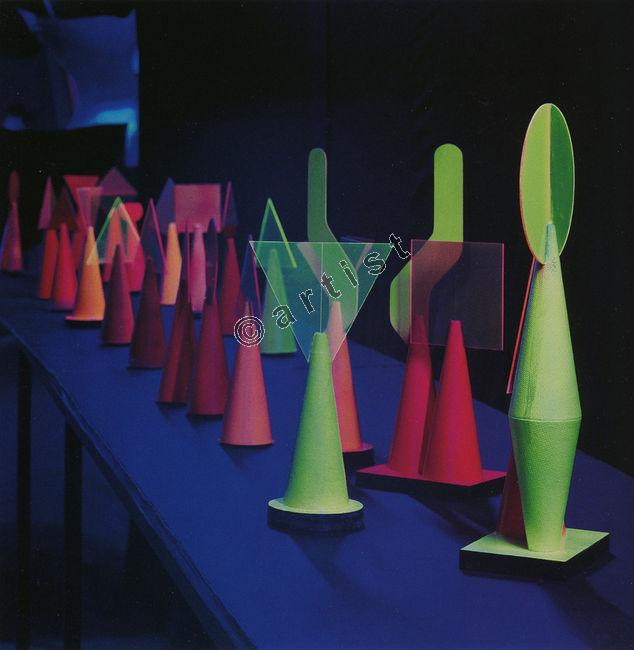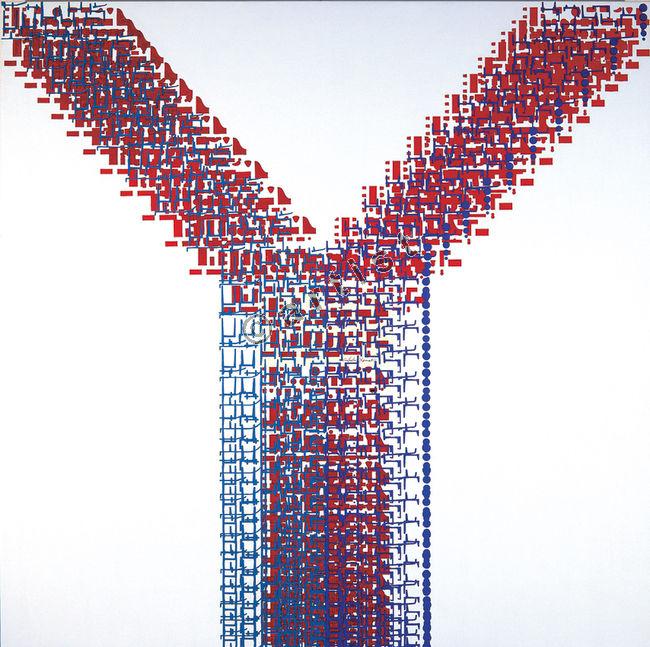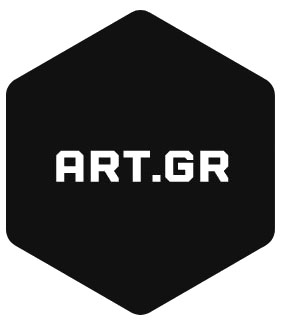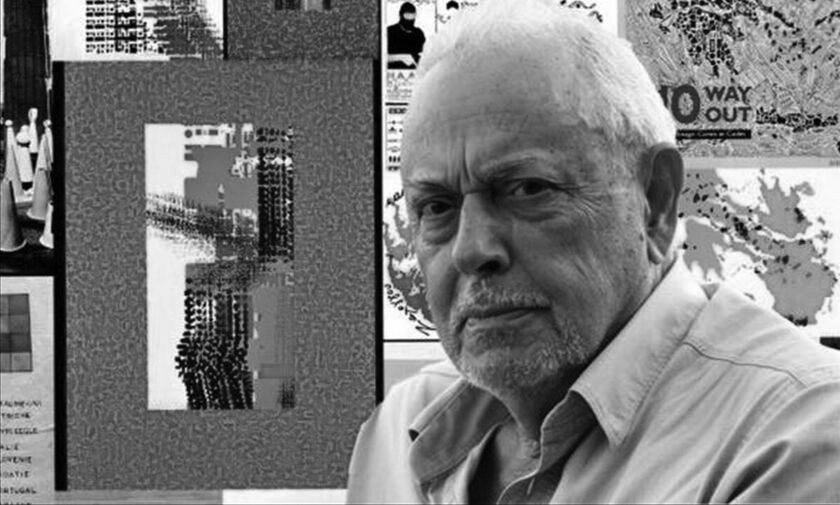He was born in 1931 in Cairo, where he took his first steps in painting. He studied in Paris (1956-1961), architecture and decoration at the École Supérieure des Arts Modernes and painting at the Académie de la Grande Chaumière.
Initially influenced by lyrical abstraction and informel, he soon began to incorporate objects into his work and experiment with movement, light and sound, organizing environments with electrokinetic constructions, often with a strong element of action, spectacle and participation. Before the end of the 1960s, his preoccupation with the most characteristic theme of his mature work had already begun: the codes, signs and symbols that convey messages and define modes of communication. Since then, his research and artistic proposals have revolved around this field.
He uses many kinds of visual media, sometimes in three-dimensional constructions or installations in space, sometimes in flat painting compositions. His personal poetic semiology borrows elements from modern life, but also from writing systems of ancient cultures. His work reveals a constant disposition to break with established forms, while at the same time being in dialogue with the cultural past.
His first solo exhibition took place in Sweden (1969, Sôdertalje Konsthal). In 1970 he went on a DAAD scholarship to Berlin, where he taught at the Schiller College and the Hochschulle fur Bildende Kuste. At that time he also presented his first solo exhibition in Greece (1971, Goethe Institute, Athens), which functioned, in the midst of the dictatorship, as a bold intervention on an artistic and political level. From 1973, settled in France, he taught at the Ecole Normale Superieure de l’Enseignement Technique (Cachan), participated in committees of educational institutions and developed intense artistic and exhibition activity in the international arena, with dozens of individual exhibitions and a large number of group exhibitions. In 1996 he was awarded the Delmas prize of the Institut de France.
From the mid-1990s, his visits to Greece become more frequent and, gradually, he begins to divide his time between Paris and Athens. In 1996, honoring his Egyptian origin, he presents a retrospective exhibition in Alexandria and Cairo entitled The Return of the Artist, 1958-1996. In Greece he exhibits in three parts the autobiographical series entitled The book of life (1995, 1997, 2003), while in 2003 there is also a retrospective presentation of his works of the last twenty years (K.M.S.T., Thessaloniki).
Two monographs on his work have been published in Greek, in 1995 and 2009.
Γεννήθηκε το 1931 στο Κάιρο, όπου έκανε και τα πρώτα του βήματα στη ζωγραφική. Σπούδασε στο Παρίσι (1956-1961), αρχιτεκτονική και διακόσμηση στην École Supérieure des Arts Modernes και ζωγραφική στην Académie de la Grande Chaumière.
Αρχικά επηρεάστηκε από τη λυρική αφαίρεση και το informel, αλλά σύντομα άρχισε να ενσωματώνει στο έργο του αντικείμενα και να πειραματίζεται με την κίνηση, το φως και τον ήχο, οργανώνοντας περιβάλλοντα με ηλεκτροκινητικές κατασκευές, συχνά με έντονο το στοιχείο της δράσης, του θεάματος και της συμμετοχής. Πριν από το τέλος της δεκαετίας του 1960, είχε ήδη ξεκινήσει και η ενασχόλησή του με το κατεξοχήν χαρακτηριστικό θέμα της ώριμης δουλειάς του: τους κώδικες, τα σημεία και τα σύμβολα, που μεταφέρουν μηνύματα και ορίζουν τρόπους επικοινωνίας. Γύρω από αυτό τον τομέα περιστρέφονται έκτοτε οι έρευνές του και οι καλλιτεχνικές του προτάσεις.
Χρησιμοποιεί πολλών ειδών εικαστικά μέσα, άλλοτε σε τρισδιάστατες κατασκευές ή εγκαταστάσεις στο χώρο, άλλοτε σε επίπεδες ζωγραφικές συνθέσεις. Η προσωπική του ποιητική σημειολογία δανείζεται στοιχεία από τη σύγχρονη ζωή, αλλά και από συστήματα γραφής παλιών πολιτισμών. Το έργο του φανερώνει μια διαρκή διάθεση ρήξης με τις καθιερωμένες φόρμες, ενώ ταυτόχρονα βρίσκεται σε διάλογο με το πολιτιστικό παρελθόν.
Η πρώτη του ατομική έκθεση έγινε στη Σουηδία (1969, Sôdertalje Konsthal). Το 1970 πήγε με υποτροφία της DΑΑD στο Βερολίνο, όπου δίδαξε στο Schiller College και στη Hochschulle fur Bildende Kuste. Εκείνη την εποχή παρουσίασε και την πρώτη του ατομική έκθεση στην Ελλάδα (1971, Ινστιτούτο Γκαίτε, Αθήνα), η οποία λειτούργησε, μέσα στη δικτατορία, σαν μια τολμηρή παρέμβαση σε καλλιτεχνικό και πολιτικό επίπεδο. Από το 1973, εγκατεστημένος στη Γαλλία, δίδαξε στην Ecole Normale Superieure de l’Enseignement Technique (Cachan), συμμετείχε σε επιτροπές εκπαιδευτικών ιδρυμάτων και ανέπτυξε έντονη καλλιτεχνική και εκθεσιακή δραστηριότητα στο διεθνή χώρο, με δεκάδες ατομικές εκθέσεις και μεγάλο αριθμό ομαδικών. Tο 1996 τιμήθηκε με το βραβείο Delmas του Institut de France.
Από τα μέσα της δεκαετίας του 1990 οι επισκέψεις του στην Ελλάδα πυκνώνουν και, βαθμιαία, αρχίζει να μοιράζει το χρόνο του μεταξύ Παρισιού και Αθήνας. Το 1996, τιμώντας την αιγυπτιώτικη καταγωγή του, παρουσιάζει στην Αλεξάνδρεια και στο Κάιρο αναδρομική έκθεση με τίτλο Η Επιστροφή του Καλλιτέχνη, 1958-1996. Στην Ελλάδα εκθέτει σε τρία μέρη την αυτοβιογραφική σειρά με τίτλο Το βιβλίο της ζωής (1995, 1997, 2003), ενώ το 2003 γίνεται και αναδρομική παρουσίαση έργων του της τελευταίας εικοσαετίας (Κ.Μ.Σ.Τ., Θεσσαλονίκη).
Έχουν κυκλοφορήσει στα ελληνικά δύο μονογραφίες για το έργο του, το 1995 και το 2009.
Biography Source | Πηγή Βιογραφικού: http://dp.iset.gr/artist/view.html?id=580
View works of Konstantinos Xenakis on Art.gr | Εργα του Κωνσταντίνου Ξενάκη στο Art.gr
